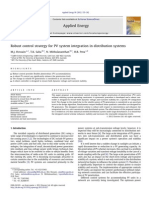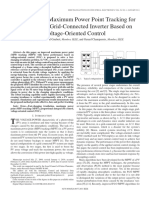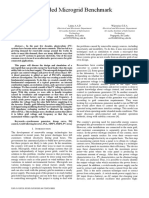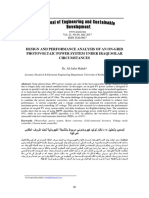Professional Documents
Culture Documents
Performance Enhancement of Photovoltaic Systems
Copyright
Available Formats
Share this document
Did you find this document useful?
Is this content inappropriate?
Report this DocumentCopyright:
Available Formats
Performance Enhancement of Photovoltaic Systems
Copyright:
Available Formats
Volume 7, Issue 5, May – 2022 International Journal of Innovative Science and Research Technology
ISSN No:-2456-2165
Performance Enhancement of Photovoltaic Systems
Shreya Rao1*, Deepthi Shetty2*, Rohan K U3*, Kishan4*, Vindhya5*
*
Dept. of Electronics & Communication Engineering.
Mangalore Institute of Technology & Engineering , Moodabidri, India
Abstract:- The Solar photovoltaic (PV) energy has many systems during climatic fluctuations. By managing the
advantages which makes it one of the great sources for reactive and active load flow in between both the photovoltaic
power generation. Photovoltaic systems are linked to the system and the grid, the DC - AC inverters control techniques,
electrical grid with the help of a DC-AC converter and a but on the other hand, aim to improve the effectiveness of grid-
DC-AC inverter. The project's major goal is to improve combined Photovoltaic system under abnormal operation
the grid's interoperability with PV installations. To get the scenarios.
desired performance, the converter as well as inverter II. LITERATURE REVIEW
characteristics are adjusted. The inverter is controlled by
an ARPI (adaptive reference PI) controller, which [1] Several control strategies were tried to control the
improves the conduction of the system by allowing for low amount of active power present in between Photovoltaic
voltage ride through (LVRT). It also smooths out the system and the grid, thereby optimizing the levels of voltage
oscillations in PV-generated electricity that occur because at PCC by modifying the grid side inverters. According to the
of the due to environmental changes. The converter is findings, PI controllers were employed to satisfy the LVRT
utilized to provide MPPT while the PV system is under requirements of Photovoltaic systems. Furthermore, by
varied environmental conditions (MPPT). To assess the managing the voltage and current of grid side inverters, PI
efficiency of the suggested method, a simulation of system controllers are commonly utilized to improvise LVRT
performance employing the suggested ARPI is provided. capabilities.
Keywords:- PV systems, PI controller, MPPT. [2] The continuous expansion in solar power output has
produced substantial integration operations and challenges for
I. INTRODUCTION power utility system engineers of present grid network. This
study focuses on the steady-state integration effects of solar
Solar photovoltaic systems have emerged as among the Photovoltaic electricity on established dissipation and
most significant forms of renewable energy production in dispense system. The study points at how steady state
recent years. This significance is universal owing to the stats combination affects the voltage level, reference voltage,
of existing PV systems and the predicted future increase. By transmission losses, voltage drop, and network voltage
2021, it was estimated and expected that roughly 1TW of stability in an existing network.
electricity will be generated in PV systems. There are several
issues in integrating Photovoltaic system to the electricity grid. [3] Specifically, in proportional plus integral and
These difficulties result in variations in the power produced by derivative (PID) feedback is the most significant and powerful
the PV system as a result of environmental changes such as concept in control systems. It is accurate and effective in all
solar irradiance and temperature, non-linearities in power sorts of control systems. The role of PID feedback, which is
electronics components, non-linearities in PV attributes such regarded the primary controller of all control loops, is
as converters and inverters, as well as reliability and stability. examined. PID is used as controller feedback in over 90% of
Grid faults are also other kind of technical challenges that control systems, and its appropriate application necessitates
show up during the unusual operating conditions. The most skills, knowledge, and controlling approaches. As a result,
common grid failures are short circuits and sagging situations, there is a qualitative analysis of PID for applications in this
which are caused by a rapid rise in load, however faults are not work.
restricted with those at the common coupling point (PCC). The
state of grid whether it is connected to PV system or not is [4] This study discusses the challenges of connecting
determined by these faults. Therefore, some measures are solar PV systems to the main grid. The performance of a grid-
needed to be taken in order to determine whether PV system integrated rooftop solar PV system, as well as the proposed
is connected or disconnected from the grid. During failures, control approach, is shown under various operating situations.
the grid will describe whether PV systems can be connected or The current solar power generating scenario in India has also
detached from the grid, as well as offer low voltage ride been examined in this research for stand-alone, grid-connected
through (LVRT) and fault ride through (FRT). There are two and rooftop PV systems.
zones depending on the PCC operating voltage during
disturbances: trip and connection. A DC-AC inverter and DC- [5] Large-scale PV grid-connected power generating
DC converter are utilized to link the Photovoltaic system to systems have posed a threat to the grid's stability and
the electrical grid. In order to increase PV system connectivity management, and also the grid-tied solar system with an
with the electrical grid, several solutions are proposed. Using energy storage device. An 8 kW PV system and an energy
a MPPT approach, a DC-DC chopper controlling mechanism depository were built to solve these challenges. The battery
is implemented to optimize the captured energy through PV constituents of the system can be linked to the grid in DC or
IJISRT22MAY2066 www.ijisrt.com 1438
Volume 7, Issue 5, May – 2022 International Journal of Innovative Science and Research Technology
ISSN No:-2456-2165
AC mode. The viability and adaptability of the MPPT charge connects to the grid. The inverter is also adjusted to increase
controller are confirmed by a dynamic model incorporated into the PV system's grid integration.
the household solar Photovoltaic system.
A DC-DC chopper control approach is used to optimise
[6] This study established a hybrid strategy based on the collected energy from Photovoltaic systems utilising a
power quality (PQ) augmentation in a grid-combined MPPT method during environmental changes like as
Photovoltaic system. The hybrid technique combines the temperature and irradiation. By controlling the active and
Radial Basis Function Neural Network (RBFNN) and reactive load that flows in between the Photovoltaic system and
Proportional Integral controllers. the system's grid, the DC to AC inverter management methods,
on the other hand, aim to improvise the performance of grid-
[7] Solar-grid assimilation is a method for combining integrated Photovoltaic systems under unusual operation
large volumes of solar energy produced by Photovoltaic or scenarios. The inverter is a controller that increases the grid
CSP systems it in to an existing power infrastructure. In areas connection of a Photovoltaic system. Photovoltaic systems use
like solar component installation, fabrication, and operation, PI controllers to meet their LVRT requirements. Furthermore,
this technique requires a lot of thought and research. PI controllers are widely utilised to increase LVRT capabilities
by controlling the current and voltage of grid side inverters. The
[8] All grid-connected solar PV power plants must install PI controllers improve the grid-connected Photovoltaic
the appropriate constituents to continually monitor solar systems' transient stability. All of the studies that have been
irradiation, surrounding temperature, wind speed, and other published have suggested using a PI controller for only the
meteorological data, as well as the generation of both DC and LVRT to improve the power transfer from Photovoltaic
AC electricity. systems to the grid. There are many trial and error methods for
determining PI control settings.
[9] This article discusses the possibility of grid-
integrated solar photovoltaic power creation system to fulfil
energy demands throughout the day and lower the
community's energy expenses. The study's initial goal is to
assess solar energy's potential as a power source for this
purpose.
[10] The influence of grid-integrated large-scale
photovoltaic on the power system working (availability,
stability and reliability) and protection philosophy is the topic
of this research. It evaluates the certification techniques and
standards of utility-interactive equipment (grid inverters),
which has a direct effect on that of the grid's supply security
and power quality.
III. PROPOSED METHOD Fig. 1: Block diagram of photovoltaic system with the grid
connection.
The adoption of an adaptive controller with the capacity
to update its settings at each of the operating situations is a B. PI Controller
viable solution for the PI controller's lack of retuning The DC link voltage is altered other than the reference
parameters. The suggested adaptive reference PI (ARPI) voltage when the operational conditions change. The power,
controller is simulated using Scilab and MATLAB to enhance current, and voltage of the inverter will all be affected by this
the performance by the on-grid Photovoltaic system. This is adjustment. The system performance will be improved if the
accomplished by softening the power fluctuations that are DC link voltage is correctly managed. The PI controller is
caused by changes in the irradiance as well as temperature. utilized as a benchmark in this study to show how successful
Furthermore, LVRT augmentation potentiality is achieved is the ARPI (adaptive reference) controller.
when failures that occur at the point of common coupling
inbetween the Photovoltaic system and the grid. In order to By managing the error signal present in between the DC
increase the efficacy of the suggested adaptive controller, the link voltage and anticipated reference value of 800 V, the
system’s execution is contrasted to that of an ideal Proportional recommended PI controller updates and stimulates the
integral controller. reference power (Pref), which is then matched to the output
power PV. The power needed from the grid to sustain the DC
A. Working connection voltage changes is the distinction between the two
A DC to DC converter and a DC to AC inverter link the powers. To generate inverter gate pulses, the PCC voltage and
PV system to the grid. The converter raises the PV system's reference current are computed, then contrasted to the inverter
output DC voltage (boost converter). Furthermore, it uses the output current.
perturb and observe MPPT approach to track maximum power,
while the inverter converts DC voltage to AC voltage and
IJISRT22MAY2066 www.ijisrt.com 1439
Volume 7, Issue 5, May – 2022 International Journal of Innovative Science and Research Technology
ISSN No:-2456-2165
C. Maximum Power Point Tracking
MPPT (Maximum power point tracking) is a method that
is used for transferring the utmost amount of energy from a
transducer. Nonlinear characteristic power curves exist in
energy transducers such as the solar modules; the ideal load
for maximum power production is determined by the operating
point for the particular parameters. This method necessitates
energy monitoring, establishing the best operating point, and
adjusting the load. A variety of strategies may be used to
calculate the ideal load.
Through a power converter, the MPPT ensures utmost
power transmission from the photovoltaic panels to the grid.
An MPPT algorithm is included in the control scheme. This
iterative process determines the current or/and voltage of the
solar photovoltaic array and serves as a reference for the
control system. This reference is then imposed at the solar
panel terminals by the power converter. Fig. 4: MATLAB-Simulink Implementation
SIMULATION RESULTS
The simulation for three PV modules was done in Scilab
XCOS as shown in Figure 2. The results show that the small
voltages are amplified to comparatively larger values. The
controller and inverter outputs are as shown in Figure 3. The
boost converter allows to get such a large amplification in the
output voltage. Such units can be combined to get a large
voltage at the grid that will help to meet the large-scale power
requirements of the society.
Fig. 5: Output obtained in Simulink implementation
The PV panel with an input of 17 parallel and 14 series
modules is obtained. The reference voltage given is 700V.
Figure 5 shows the parameters obtained in Simulink
implementation.
IV. CONCLUSION
Fig. 2: Scilab-XCOS model of 3 connected PV modules The analysis and simulation of the PV system and grid
connections are done in the open source software Scilab and
MATLAB Simulink. The Scilab features of SciNotes and
XCOS are used for the simulations. The suggested control
strategy aids in improving PV system grid integration by
attaining MPPT and softening power fluctuations caused by
environmental variations such as solar irradiance and
temperature. Furthermore, it facilitates the grid-connected
Photovoltaic system's LVRT functionality during three-phase
outages at PCC. This system aids in the enhancement of LVRT
capacity by acting as a protective mechanism whenever the
DC link fails.
Fig. 3: Inverter and converter output in XCOS
IJISRT22MAY2066 www.ijisrt.com 1440
Volume 7, Issue 5, May – 2022 International Journal of Innovative Science and Research Technology
ISSN No:-2456-2165
REFERENCES [13]. J. Sreedevi, Ashwin N, M. Naini Raju, “A Study on Grid
Connected PV system”, IEEE 2016.
[1]. Ayman Alhejji, Mohamed I. Mosaad, “Performance [14]. Hamza B. Al Smadi, “Overview of Grid-Connected PV
enhancement of grid-connected PV systems using Systems Challenges with Regards to Grid Stability”,
adaptive reference PI controller”, Ain Shams May 2018.
Engineering Journal, 25 September 2020. [15]. Muhammad Saad Iqbal, Yasir Amir Khan Niazi, Umer
[2]. Nhamo Dhlamini, S.P Daniel Chowdhury, “Solar Amir Khan a, Bang-Wook Lee. “Real-time fault
Photovoltaic Generation and its Integration Impact on the detection system for large scale grid integrated solar
Existing Power Grid”, IEEE PES/IAS PowerAfrica, photovoltaic power plants”, International Journal of
2018. Electrical Power and Energy Systems, 2021.
[3]. Khan Nouman, Zaman Asim, Khan Qasim, [16]. Ayaz Ahma, L. Rajaji, A. Iqbal., “A novel current
“Comprehensive Study on performance of PID controller design for grid integrated PV inverter system”,
Controller and its Applications”, 2nd IEEE Advanced Research Article, 28 January 2021.
Information Management, Communicates, Electronic [17]. Priyabrata Pattanaik, “Boost Converter based on
and Automation Control Conference (IMCEC), 2018. Photovoltaic Energy System”, International Journal of
[4]. Mahesh Kumar, “Technical Issues and Performance Innovative Technology and Exploring Engineering
Analysis for Grid Connected PV System and Present (IJITEE) ISSN: 2278-3075, Volume-8, Issue-11S,
Solar Power Scenario”, International Conference on September 2019.
Electrical and Electronics Engineering (ICE3) 2020. [18]. K. Umadevi, Dr. C. Nagarajan, “Photovoltaic System
[5]. Jerry Kumar, Nanik Ram Parhyar, Manoj Kumar With Dc-Dc Boost Converter Topology Using Psim
Panjwani, Danish Khan, “Design and performance Software”, International Journal of Current Research and
analysis of PV grid-tied system with energy storage Modern Education (IJCRME), NCFTCCPS - 2016.
system”, International Journal of Electrical and [19]. Akhil Raja, R.P.Praveen, “Highly efficient DC-DC boost
Computer Engineering (IJECE), 2020. converter implemented with improved MPPT algorithm
[6]. B.G. Sujatha, G.S. Anitha, “Enhancement of PQ in grid for utility level photovoltaic applications”, Ain Shams
connected PV system using hybrid technique”, Ain Engineering Journal, Volume 13, Issue 3, May 2022.
Shams Engineering Journal, Volume 8, NO. 6, June [20]. R. Uthirasamy, V. Kumar Chinnaiyan, S. Vishnukumar,
2016. Alagar Karthick, V. Mohanavel , Umashankar
[7]. K.N. Nwaigwe, P. Mutabilwa, E. Dintwa, “An overview Subramaniam and M. Muhibbullah, “Design of Boosted
of solar power (PV systems) integration into electricity Multilevel DC-DC Converter for Solar Photovoltaic
grids”, Materials Science for Energy Technologies, System”, International Journal of Photoenergy, Volume
KeAi, 16 July 2019. 2022.
[8]. Harish Kumar Khyani, Dr. Jayashri Vajpai, “Integration [21]. Yavuz Bahadır Koca, Yılmaz Aslan, Ahmet Yonetken,
of Solar PV Systems to the Grid: Issues and Challenges”, Yuksel Oguz, “Boost Converter Design and Analysis for
International Journal of Engineering Research & Photovoltaic Systems”, 4th International Conferenceon
Technology (IJERT), ISSN: 2278-0181, ETRASCT' 14 Engineering Technology and Applied Sciences
Conference Proceedings. (ICETAS), April 2019.
[9]. Youssef Kassem, Huseyin Gokçekus and Ali Guvensoy, [22]. Fernando M. Oliveira, Sergio A. O. da Silva, Fabio R.
“Techno-Economic Feasibility of Grid-Connected Solar Durand, Leonardo P. Sampaio, “Application of PSO
PV System at Near East University Hospital, Northern Method for Maximum Power Point Extraction in
Cyprus”, MDPI, 15 November 2021. Photovoltaic Systems Under Partial Shading
[10]. Erik DE JONG, Peter VAESSEN, “The Impact Of Conditions”, IEEE, 2015.
Large-Scale PV On Distribution Grid Operation And [23]. Gancalo Calvinho, Jose Mariano, Maria Do Rosario
Protection; And Appropriate Testing”, CIRED, CIRED Calado, “Design and Implementation of MPPT System
Workshop - Lisbon 29-30 May 2012. Based on PSO Algorithm”, International Conference on
[11]. Bipin Singh, Arunima Verma, Vinod Kumar Giri, Intelligent Systems (IS), IEEE, 2018.
“Power Quality Improvement of Grid Connected PV [24]. Amit Kumer Podder, Naruttam Kumar Roy, Hemanshu
System”, IEEE India Council International Subsections Roy Pota, “MPPT methods for solar PV systems: a
Conference (INDISCON), 2020. critical review based on tracking nature”, The Institution
[12]. Noha Eissa Morsy, Mahmoud A. Attia, Almoataz Y. of Engineering and Technology, 2019.
Abdelaziz, Neeraj Kanwar, “Optimization of the PI [25]. Salman Salman, Xin AI and Zhouyang WU, “Design of
controller to improve the dynamic performance of grid- a P-&-O algorithm based MPPT charge controller for a
connected photovoltaic system”, IEEE, 2019. stand-alone 200W PV system”, Protection and Control of
Modern Power Systems, 2018.
IJISRT22MAY2066 www.ijisrt.com 1441
You might also like
- Dell Inspiron 5379 5579 7773 16888-1 Starlord ROR-L A00Document106 pagesDell Inspiron 5379 5579 7773 16888-1 Starlord ROR-L A00Jerzy LisowskiNo ratings yet
- 10 35378-Gujs 899799-1649221Document20 pages10 35378-Gujs 899799-1649221TabishNo ratings yet
- Review Article: Research Survey On Various MPPT Performance Issues To Improve The Solar PV System EfficiencyDocument21 pagesReview Article: Research Survey On Various MPPT Performance Issues To Improve The Solar PV System EfficiencyShubhamNo ratings yet
- Design and Performance Analysis of An On-Grid Photovoltaic Power System Under Iraqi Solar CircumstancesDocument13 pagesDesign and Performance Analysis of An On-Grid Photovoltaic Power System Under Iraqi Solar CircumstancesAgung Bagus SajiwoNo ratings yet
- Applied Energy: M.J. Hossain, T.K. Saha, N. Mithulananthan, H.R. PotaDocument8 pagesApplied Energy: M.J. Hossain, T.K. Saha, N. Mithulananthan, H.R. PotaAlok AgarwalNo ratings yet
- Report ProjectDocument17 pagesReport ProjectMAGUDESWARAN PNo ratings yet
- Effect of Partial Shading in Grid Connected Solar PV System With FL ControllerDocument10 pagesEffect of Partial Shading in Grid Connected Solar PV System With FL ControllerPtuan ThanhNo ratings yet
- 2008 Filomena Salim Resener Bretas IEEE 1Document9 pages2008 Filomena Salim Resener Bretas IEEE 1ali didebanNo ratings yet
- A New Fuzzy Based INC MPPT Algorithm ForDocument6 pagesA New Fuzzy Based INC MPPT Algorithm Forcharushila patelNo ratings yet
- Iccicct - 507 PDFDocument5 pagesIccicct - 507 PDFGlan DevadhasNo ratings yet
- Solar - Photovoltaic - Generators - With - MPPT - and - BatterDocument12 pagesSolar - Photovoltaic - Generators - With - MPPT - and - BatterCB MildredNo ratings yet
- Frequency and Voltage Stabilit-IRO-Journals-4 4 4Document20 pagesFrequency and Voltage Stabilit-IRO-Journals-4 4 4aliebadizahedan.375No ratings yet
- An Efficient Constant Current Controller For PV Solar Power Generator Integrated With The GridDocument6 pagesAn Efficient Constant Current Controller For PV Solar Power Generator Integrated With The GridsunilkumareceNo ratings yet
- Renewable Energy: Muhammad Talha, S.R.S. Raihan, N Abd RahimDocument16 pagesRenewable Energy: Muhammad Talha, S.R.S. Raihan, N Abd RahimsharvinNo ratings yet
- Integration Monitoring of On-Grid Photovoltaic System: Case StudyDocument7 pagesIntegration Monitoring of On-Grid Photovoltaic System: Case Studyانيس انيسNo ratings yet
- Red DEv and Tripathi Journal PaperDocument10 pagesRed DEv and Tripathi Journal PaperMichael Zontche BernardNo ratings yet
- IET Generation Trans Dist - 2021 - BagchiDocument12 pagesIET Generation Trans Dist - 2021 - BagchiMohamed SobhyNo ratings yet
- Simulation of PV System With MPPT and Boost Converter: March 2014Document8 pagesSimulation of PV System With MPPT and Boost Converter: March 2014Vishal KevatNo ratings yet
- Highly Efficient Analog Maximum Power Point Tracking (AMPPT) in A Photovoltaic SystemDocument11 pagesHighly Efficient Analog Maximum Power Point Tracking (AMPPT) in A Photovoltaic SystemSusmita PandaNo ratings yet
- Control of Grid Connected PV Array Using P&O MPPT AlgorithmDocument7 pagesControl of Grid Connected PV Array Using P&O MPPT AlgorithmHương B DlightNo ratings yet
- 48 An Improved Maximum Power Point Tracking For PDFDocument10 pages48 An Improved Maximum Power Point Tracking For PDFSouhaib LoudaNo ratings yet
- 824 June 2019Document8 pages824 June 2019Katta VenkateshNo ratings yet
- Design and Simulation of Grid Connected PV System With Hybrid Inverter Using MATLAB/SimulinkDocument7 pagesDesign and Simulation of Grid Connected PV System With Hybrid Inverter Using MATLAB/SimulinkFawkes SangNo ratings yet
- Nonlinear Adaptive Backstepping ControllDocument19 pagesNonlinear Adaptive Backstepping Controllprof zinssNo ratings yet
- Energies 16 03245Document20 pagesEnergies 16 03245khannoussi kamiliaNo ratings yet
- Research Survey on Improving Solar PV System EfficiencyDocument22 pagesResearch Survey on Improving Solar PV System EfficiencyKasehun GetinetNo ratings yet
- A Control Methodology of Three Phase Grid Connected PV SystemDocument8 pagesA Control Methodology of Three Phase Grid Connected PV SystemBojan BankovicNo ratings yet
- Power Factor Improvement and MPPT of The Grid-Connected Solar Photovoltaic System Using Nonlinear Integral Backstepping ControllerDocument18 pagesPower Factor Improvement and MPPT of The Grid-Connected Solar Photovoltaic System Using Nonlinear Integral Backstepping ControllerAbdullah BhuttaNo ratings yet
- Islanded Microgrid BenchmarkDocument7 pagesIslanded Microgrid BenchmarkDinithi LaknaNo ratings yet
- Jin 2021 J. Phys. Conf. Ser. 1754 012001Document7 pagesJin 2021 J. Phys. Conf. Ser. 1754 012001Florin FlorinNo ratings yet
- A Grid Tied SPV System With Adaptive DC Link Voltage For CPI Voltage Variations Using Fuzzy Logic ControlDocument9 pagesA Grid Tied SPV System With Adaptive DC Link Voltage For CPI Voltage Variations Using Fuzzy Logic ControlAbhinav ShendageNo ratings yet
- Design of Photovoltaic Based Battery Charger Using Sliding Mode MPPT ControlDocument7 pagesDesign of Photovoltaic Based Battery Charger Using Sliding Mode MPPT ControlMazoon ButtNo ratings yet
- GridDocument6 pagesGridgiongan342No ratings yet
- Design of PV System With Double Boost ConverterDocument53 pagesDesign of PV System With Double Boost ConverterBalamurugan100% (1)
- Energies 15 01286 v2Document22 pagesEnergies 15 01286 v2prof zinssNo ratings yet
- Prerna 2016Document5 pagesPrerna 2016Jorge CarrionNo ratings yet
- Control Technique For Single Phase Inverter Photovoltaic Syst - 2020 - Energy ReDocument9 pagesControl Technique For Single Phase Inverter Photovoltaic Syst - 2020 - Energy ReИлия ГеоргиевNo ratings yet
- Grid ControlDocument12 pagesGrid ControlNITIN MISHRANo ratings yet
- Midterm Report on Two-Stage Grid-Connected InverterDocument11 pagesMidterm Report on Two-Stage Grid-Connected Inverterdr.Sabita shresthaNo ratings yet
- 884 Ijr June 2019Document14 pages884 Ijr June 2019MANTEL TELECOMNo ratings yet
- A Single Phase Photovoltaic Inverter Control For Grid Connected SystemDocument16 pagesA Single Phase Photovoltaic Inverter Control For Grid Connected SystemRAMPRASATH EEENo ratings yet
- Design and Implementation of Three Phase Solar PV Integrated UPQC Based On Artificial Neural NetworksDocument7 pagesDesign and Implementation of Three Phase Solar PV Integrated UPQC Based On Artificial Neural NetworksIJRASETPublicationsNo ratings yet
- A Three-Phase Grid Tied SPV System With Adaptive DC Link Voltage For CPI Voltage VariationsDocument8 pagesA Three-Phase Grid Tied SPV System With Adaptive DC Link Voltage For CPI Voltage VariationsAayesha AhmedNo ratings yet
- A Unified Control and Power Management Scheme For PV-Battery-Based Hybrid Microgrids For Both Grid-Connected and Islanded ModesDocument11 pagesA Unified Control and Power Management Scheme For PV-Battery-Based Hybrid Microgrids For Both Grid-Connected and Islanded ModesBrightworld ProjectsNo ratings yet
- Design and Implementation of Three Phase To Single Phase Solid State TransformerDocument37 pagesDesign and Implementation of Three Phase To Single Phase Solid State TransformerUsha SreeNo ratings yet
- Energy management for hybrid wind-solar-battery microgridDocument10 pagesEnergy management for hybrid wind-solar-battery microgridsamraat sharmaNo ratings yet
- +design and Implementation of A Low CostDocument9 pages+design and Implementation of A Low CostmabhatNo ratings yet
- Renewable and Sustainable Energy Reviews: A B A A C A C ADocument22 pagesRenewable and Sustainable Energy Reviews: A B A A C A C ADAVID ASNANGNo ratings yet
- Advancing Grid-Connected Renewable Generation SystDocument4 pagesAdvancing Grid-Connected Renewable Generation Systamina bu bakerNo ratings yet
- A Small Grid-Connected PV System Controlled by The PLCDocument2 pagesA Small Grid-Connected PV System Controlled by The PLCtongaiNo ratings yet
- Dynamic Voltage Support For Low-Voltage Ride-Through Operation in Single-Phase Grid-Connected Photovoltaic SystemsDocument10 pagesDynamic Voltage Support For Low-Voltage Ride-Through Operation in Single-Phase Grid-Connected Photovoltaic Systemskhannoussi kamiliaNo ratings yet
- 2013c - Sliding Mode Control Based Power Balancing For Grid ConnectedDocument6 pages2013c - Sliding Mode Control Based Power Balancing For Grid ConnectedP. K. SahuNo ratings yet
- 1 s2.0 S0378779623008337 MainDocument17 pages1 s2.0 S0378779623008337 MainS RoyNo ratings yet
- A Study On Grid Connected PV SystemDocument6 pagesA Study On Grid Connected PV SystemsamNo ratings yet
- A Control Strategy For Implementation of Enhanced Voltage Quality in Micro GridDocument7 pagesA Control Strategy For Implementation of Enhanced Voltage Quality in Micro GriderpublicationNo ratings yet
- Wo-Loop Con Aximizing Erfo Mance O Grid-Connected - Fuel Cell Ihybrid PowerDocument6 pagesWo-Loop Con Aximizing Erfo Mance O Grid-Connected - Fuel Cell Ihybrid PowerVelagandula AvinashNo ratings yet
- Analysis and Implement of Hybrid ANN PandO Based MPPT Controller To Enhance Efficiency of Photovoltaic SystemDocument12 pagesAnalysis and Implement of Hybrid ANN PandO Based MPPT Controller To Enhance Efficiency of Photovoltaic SystemEditor IJTSRDNo ratings yet
- PV Inverter TopoligiesDocument6 pagesPV Inverter TopoligieslegioNo ratings yet
- Design and Performance Analysis of an On-Grid Photovoltaic Power SystemDocument12 pagesDesign and Performance Analysis of an On-Grid Photovoltaic Power Systemسعيد ابوسريعNo ratings yet
- Fault Analysis of Grid Connected Photovoltaic SystDocument11 pagesFault Analysis of Grid Connected Photovoltaic SystSasi prasadNo ratings yet
- Formulation and Evaluation of Poly Herbal Body ScrubDocument6 pagesFormulation and Evaluation of Poly Herbal Body ScrubInternational Journal of Innovative Science and Research TechnologyNo ratings yet
- Comparatively Design and Analyze Elevated Rectangular Water Reservoir with and without Bracing for Different Stagging HeightDocument4 pagesComparatively Design and Analyze Elevated Rectangular Water Reservoir with and without Bracing for Different Stagging HeightInternational Journal of Innovative Science and Research TechnologyNo ratings yet
- Explorning the Role of Machine Learning in Enhancing Cloud SecurityDocument5 pagesExplorning the Role of Machine Learning in Enhancing Cloud SecurityInternational Journal of Innovative Science and Research TechnologyNo ratings yet
- A Review: Pink Eye Outbreak in IndiaDocument3 pagesA Review: Pink Eye Outbreak in IndiaInternational Journal of Innovative Science and Research TechnologyNo ratings yet
- Design, Development and Evaluation of Methi-Shikakai Herbal ShampooDocument8 pagesDesign, Development and Evaluation of Methi-Shikakai Herbal ShampooInternational Journal of Innovative Science and Research Technology100% (3)
- Studying the Situation and Proposing Some Basic Solutions to Improve Psychological Harmony Between Managerial Staff and Students of Medical Universities in Hanoi AreaDocument5 pagesStudying the Situation and Proposing Some Basic Solutions to Improve Psychological Harmony Between Managerial Staff and Students of Medical Universities in Hanoi AreaInternational Journal of Innovative Science and Research TechnologyNo ratings yet
- A Survey of the Plastic Waste used in Paving BlocksDocument4 pagesA Survey of the Plastic Waste used in Paving BlocksInternational Journal of Innovative Science and Research TechnologyNo ratings yet
- Electro-Optics Properties of Intact Cocoa Beans based on Near Infrared TechnologyDocument7 pagesElectro-Optics Properties of Intact Cocoa Beans based on Near Infrared TechnologyInternational Journal of Innovative Science and Research TechnologyNo ratings yet
- Auto Encoder Driven Hybrid Pipelines for Image Deblurring using NAFNETDocument6 pagesAuto Encoder Driven Hybrid Pipelines for Image Deblurring using NAFNETInternational Journal of Innovative Science and Research TechnologyNo ratings yet
- Cyberbullying: Legal and Ethical Implications, Challenges and Opportunities for Policy DevelopmentDocument7 pagesCyberbullying: Legal and Ethical Implications, Challenges and Opportunities for Policy DevelopmentInternational Journal of Innovative Science and Research TechnologyNo ratings yet
- Navigating Digitalization: AHP Insights for SMEs' Strategic TransformationDocument11 pagesNavigating Digitalization: AHP Insights for SMEs' Strategic TransformationInternational Journal of Innovative Science and Research TechnologyNo ratings yet
- Hepatic Portovenous Gas in a Young MaleDocument2 pagesHepatic Portovenous Gas in a Young MaleInternational Journal of Innovative Science and Research TechnologyNo ratings yet
- Review of Biomechanics in Footwear Design and Development: An Exploration of Key Concepts and InnovationsDocument5 pagesReview of Biomechanics in Footwear Design and Development: An Exploration of Key Concepts and InnovationsInternational Journal of Innovative Science and Research TechnologyNo ratings yet
- Automatic Power Factor ControllerDocument4 pagesAutomatic Power Factor ControllerInternational Journal of Innovative Science and Research TechnologyNo ratings yet
- Formation of New Technology in Automated Highway System in Peripheral HighwayDocument6 pagesFormation of New Technology in Automated Highway System in Peripheral HighwayInternational Journal of Innovative Science and Research TechnologyNo ratings yet
- Drug Dosage Control System Using Reinforcement LearningDocument8 pagesDrug Dosage Control System Using Reinforcement LearningInternational Journal of Innovative Science and Research TechnologyNo ratings yet
- The Effect of Time Variables as Predictors of Senior Secondary School Students' Mathematical Performance Department of Mathematics Education Freetown PolytechnicDocument7 pagesThe Effect of Time Variables as Predictors of Senior Secondary School Students' Mathematical Performance Department of Mathematics Education Freetown PolytechnicInternational Journal of Innovative Science and Research TechnologyNo ratings yet
- Mobile Distractions among Adolescents: Impact on Learning in the Aftermath of COVID-19 in IndiaDocument2 pagesMobile Distractions among Adolescents: Impact on Learning in the Aftermath of COVID-19 in IndiaInternational Journal of Innovative Science and Research TechnologyNo ratings yet
- Securing Document Exchange with Blockchain Technology: A New Paradigm for Information SharingDocument4 pagesSecuring Document Exchange with Blockchain Technology: A New Paradigm for Information SharingInternational Journal of Innovative Science and Research TechnologyNo ratings yet
- Perceived Impact of Active Pedagogy in Medical Students' Learning at the Faculty of Medicine and Pharmacy of CasablancaDocument5 pagesPerceived Impact of Active Pedagogy in Medical Students' Learning at the Faculty of Medicine and Pharmacy of CasablancaInternational Journal of Innovative Science and Research TechnologyNo ratings yet
- Intelligent Engines: Revolutionizing Manufacturing and Supply Chains with AIDocument14 pagesIntelligent Engines: Revolutionizing Manufacturing and Supply Chains with AIInternational Journal of Innovative Science and Research TechnologyNo ratings yet
- Enhancing the Strength of Concrete by Using Human Hairs as a FiberDocument3 pagesEnhancing the Strength of Concrete by Using Human Hairs as a FiberInternational Journal of Innovative Science and Research TechnologyNo ratings yet
- Exploring the Clinical Characteristics, Chromosomal Analysis, and Emotional and Social Considerations in Parents of Children with Down SyndromeDocument8 pagesExploring the Clinical Characteristics, Chromosomal Analysis, and Emotional and Social Considerations in Parents of Children with Down SyndromeInternational Journal of Innovative Science and Research TechnologyNo ratings yet
- Supply Chain 5.0: A Comprehensive Literature Review on Implications, Applications and ChallengesDocument11 pagesSupply Chain 5.0: A Comprehensive Literature Review on Implications, Applications and ChallengesInternational Journal of Innovative Science and Research TechnologyNo ratings yet
- Teachers' Perceptions about Distributed Leadership Practices in South Asia: A Case Study on Academic Activities in Government Colleges of BangladeshDocument7 pagesTeachers' Perceptions about Distributed Leadership Practices in South Asia: A Case Study on Academic Activities in Government Colleges of BangladeshInternational Journal of Innovative Science and Research TechnologyNo ratings yet
- Advancing Opthalmic Diagnostics: U-Net for Retinal Blood Vessel SegmentationDocument8 pagesAdvancing Opthalmic Diagnostics: U-Net for Retinal Blood Vessel SegmentationInternational Journal of Innovative Science and Research TechnologyNo ratings yet
- The Making of Self-Disposing Contactless Motion-Activated Trash Bin Using Ultrasonic SensorsDocument7 pagesThe Making of Self-Disposing Contactless Motion-Activated Trash Bin Using Ultrasonic SensorsInternational Journal of Innovative Science and Research TechnologyNo ratings yet
- Natural Peel-Off Mask Formulation and EvaluationDocument6 pagesNatural Peel-Off Mask Formulation and EvaluationInternational Journal of Innovative Science and Research TechnologyNo ratings yet
- Beyond Shelters: A Gendered Approach to Disaster Preparedness and Resilience in Urban CentersDocument6 pagesBeyond Shelters: A Gendered Approach to Disaster Preparedness and Resilience in Urban CentersInternational Journal of Innovative Science and Research TechnologyNo ratings yet
- Handling Disruptive Behaviors of Students in San Jose National High SchoolDocument5 pagesHandling Disruptive Behaviors of Students in San Jose National High SchoolInternational Journal of Innovative Science and Research TechnologyNo ratings yet
- List of Companies Empanelled With UPDESCODocument5 pagesList of Companies Empanelled With UPDESCOriju nairNo ratings yet
- DXCDocument3 pagesDXCmukesh21982No ratings yet
- AMTL 3HP DOL StarterDocument8 pagesAMTL 3HP DOL StarterAnonymous o8XgyS1No ratings yet
- Simulink Bms Development White PaperDocument15 pagesSimulink Bms Development White PaperDIMI EKONGA NZELLYNo ratings yet
- Inamics: SINAMICS S120 - News March 2007Document33 pagesInamics: SINAMICS S120 - News March 2007mfonseca31No ratings yet
- Conect OresDocument172 pagesConect OresJuan Diego García LópezNo ratings yet
- 2 Equivalent Circuits of Power TransformersDocument56 pages2 Equivalent Circuits of Power TransformersShahzad BhattiNo ratings yet
- Number System & Logic GatesDocument24 pagesNumber System & Logic GatesA B Shinde100% (7)
- Owner'S Manual For Travel Frequency Control System: BPP6-2QM4V3-76J0Document21 pagesOwner'S Manual For Travel Frequency Control System: BPP6-2QM4V3-76J0jorgemegok1860No ratings yet
- Overview: Brushless DC Motor Driver Circuit Using 555 ICDocument4 pagesOverview: Brushless DC Motor Driver Circuit Using 555 ICJanet Walde100% (1)
- ELE 3305 Power Supply DesignDocument23 pagesELE 3305 Power Supply DesignMuhammad SalisNo ratings yet
- Programmable Logic Devices: Mohammed Anvar P.K Ap/Ece Al-Ameen Engineering CollegeDocument52 pagesProgrammable Logic Devices: Mohammed Anvar P.K Ap/Ece Al-Ameen Engineering CollegeThahsin ThahirNo ratings yet
- JPx-SBRO-005-E TornatechDocument2 pagesJPx-SBRO-005-E TornatechIrcham MaulanaNo ratings yet
- IRLB4132PbF International RectifierDocument9 pagesIRLB4132PbF International RectifierJORGENo ratings yet
- Cost To Cost Price ListDocument4 pagesCost To Cost Price ListSuneet SinghNo ratings yet
- Power System Automation PDFDocument42 pagesPower System Automation PDFyxp2237No ratings yet
- Spécifications Behringer+000+b0p01+Ppa200Document1 pageSpécifications Behringer+000+b0p01+Ppa200ZubNo ratings yet
- High-Efficiency Pure Sine Wave InverterDocument5 pagesHigh-Efficiency Pure Sine Wave Invertermariojrm74No ratings yet
- FTTH Drop and Indoor CablesDocument8 pagesFTTH Drop and Indoor Cablesvijay_786No ratings yet
- EasyLogic PM2000 Series - METSEPM2210Document3 pagesEasyLogic PM2000 Series - METSEPM2210Vinay SakethNo ratings yet
- Speech Enhancement Technical PaperDocument8 pagesSpeech Enhancement Technical PaperPuli BalajiNo ratings yet
- Sect. 3.3 Construction of Equivalent Circuit ModelDocument8 pagesSect. 3.3 Construction of Equivalent Circuit ModelPiero TorpocoNo ratings yet
- Automatic Water Pump Controller Project ReportDocument44 pagesAutomatic Water Pump Controller Project ReportNitin Verma100% (1)
- 489 Generator Management Relay FAQ: GE MultilinDocument4 pages489 Generator Management Relay FAQ: GE MultilinasdrubalaraujoNo ratings yet
- FM300 CommunicatorDocument4 pagesFM300 CommunicatoredgardomestreNo ratings yet
- White Paper Distribution Network ProtectionDocument5 pagesWhite Paper Distribution Network ProtectionAhmed Hamzeh100% (1)
- 9600LHN+1 R RRA THB Ed04Document262 pages9600LHN+1 R RRA THB Ed04Maria Canales OliveiraNo ratings yet
- Led RGB MatrixDocument18 pagesLed RGB MatrixJorge Arévalo MilletNo ratings yet
- DVB-S2 Communication Chain ProjectDocument15 pagesDVB-S2 Communication Chain ProjectHuongNguyenNo ratings yet























































































































